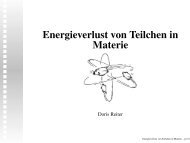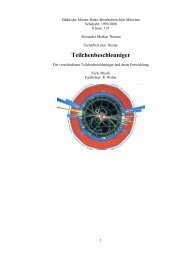The FEE Server Control Engine of the ALICE-TRD - Westfälische ...
The FEE Server Control Engine of the ALICE-TRD - Westfälische ...
The FEE Server Control Engine of the ALICE-TRD - Westfälische ...
Create successful ePaper yourself
Turn your PDF publications into a flip-book with our unique Google optimized e-Paper software.
5 <strong>The</strong> <strong>FEE</strong><strong>Server</strong> <strong>Control</strong> <strong>Engine</strong><br />
<strong>the</strong> ADC values UADC to a temperature is done with <strong>the</strong> formula<br />
temperature in°C =<br />
) − 11.6753<br />
°C − 273.15°C (5.2)<br />
−0.0394864<br />
ln( 3.3−UADC<br />
UADC<br />
<strong>The</strong> calibration values and most <strong>of</strong> <strong>the</strong> functions in <strong>the</strong> classes adc_device, voltage_sensor<br />
and temp_sensor were taken from existing C programs.<br />
<strong>The</strong> temperature sensor readout in <strong>the</strong> MCMs requires more elaborate readout functions.<br />
In principle, each MCM temperature sensor requires an individual calibration.<br />
Fur<strong>the</strong>rmore <strong>the</strong> sensors do not work reliably and <strong>the</strong>refore a runtime identification <strong>of</strong><br />
non-working sensors is required. In this section only <strong>the</strong> main functions used for <strong>the</strong><br />
temperature readout are described. A detailed description <strong>of</strong> <strong>the</strong> temperature sensors<br />
<strong>the</strong>mself is given in chapter 6.<br />
<strong>The</strong> class Temp<strong>Control</strong> (trdce) encapsulates <strong>the</strong> readout <strong>of</strong> <strong>the</strong> temperature sensors.<br />
Each time <strong>the</strong> function void Temp<strong>Control</strong>::measure(void) is called, <strong>the</strong> current temperature<br />
sensor value <strong>of</strong> all MCMs on <strong>the</strong> readout chamber is read out and printed to <strong>the</strong> logging<br />
system. An example <strong>of</strong> <strong>the</strong> output in case <strong>of</strong> printing absolute ADC values is given in<br />
listing 6.1 on page 79. <strong>The</strong> output format can be set via <strong>the</strong> extended SCSN command<br />
SCSN_CMD_MCMTEMP (see table B.2). To read out <strong>the</strong> sensors, first a write frame is<br />
send to all MCMs to trigger a measurement and afterwards <strong>the</strong> measured values are read<br />
out via SCSN read frames.<br />
Temp<strong>Control</strong> provides <strong>the</strong> function Temp<strong>Control</strong>::learnConfig(struct cfdat_temp_calib * ) to<br />
set calibration values for each MCM individually. However, it turned out that an individual<br />
calibration <strong>of</strong> <strong>the</strong> temperature sensors is not feasible (see chapter 6). <strong>The</strong>refore<br />
Temp<strong>Control</strong>::learnConfig(struct cfdat_temp_calib * ) is mainly kept for historical reasons.<br />
As a consequence, <strong>the</strong> function void Temp<strong>Control</strong>::measure(void) cannot print meaningful<br />
temperatures but prints out <strong>the</strong> raw ADC values <strong>of</strong> <strong>the</strong> temperature sensors or <strong>the</strong> difference<br />
between <strong>the</strong> first measured ADC value after switching on <strong>the</strong> MCMs and <strong>the</strong> current<br />
ADC value, depending on configuration.<br />
<strong>The</strong> identification <strong>of</strong> non-working temperature sensors is performed during <strong>the</strong> transition<br />
from STDBY to STDBY_INIT. <strong>The</strong> function CEStateMachine::triggerTransition() calls<br />
Temp<strong>Control</strong>::apply(void). This function reads out each MCM temperature sensor ten<br />
times and stores <strong>the</strong> results in <strong>the</strong> instances <strong>of</strong> MCMChip. For each MCM <strong>the</strong> class<br />
Temp<strong>Control</strong> contains one instance <strong>of</strong> class MCMChip which stores <strong>the</strong> last ten sensor readings<br />
and status information.<br />
Afterwards <strong>the</strong> function bool Temp<strong>Control</strong>::calcStatus(void) is called. This function calls<br />
bool MCMChip::calcStatus(void) for each instance. bool MCMChip::calcStatus(void) uses <strong>the</strong><br />
previously stored ten values to check if <strong>the</strong> temperature sensor does work or not and<br />
sets <strong>the</strong> corresponding status in class MCMChip. <strong>The</strong>n bool Temp<strong>Control</strong>::calcStatus(void)<br />
counts <strong>the</strong> number <strong>of</strong> non-working sensors. If this number is below a threshold which<br />
can be set via <strong>the</strong> extended SCSN command SCSN_CMD_MCMTEMP (see table B.2), <strong>the</strong><br />
MCMs are switched <strong>of</strong>f for a short time. It turned out that this procedure increases <strong>the</strong><br />
number <strong>of</strong> working sensors significantly (see chapter 6). After <strong>the</strong> MCMs were switched<br />
on again, <strong>the</strong> identification procedure is repeated.<br />
In <strong>the</strong> output <strong>of</strong> void Temp<strong>Control</strong>::measure(void) non-working sensors are represented<br />
by -1 in case <strong>of</strong> <strong>the</strong> absolute ADC values are printed since <strong>the</strong> possible range for real<br />
values is 0 to 1023, or by 999 in case <strong>of</strong> ADC differences are printed out.<br />
59







